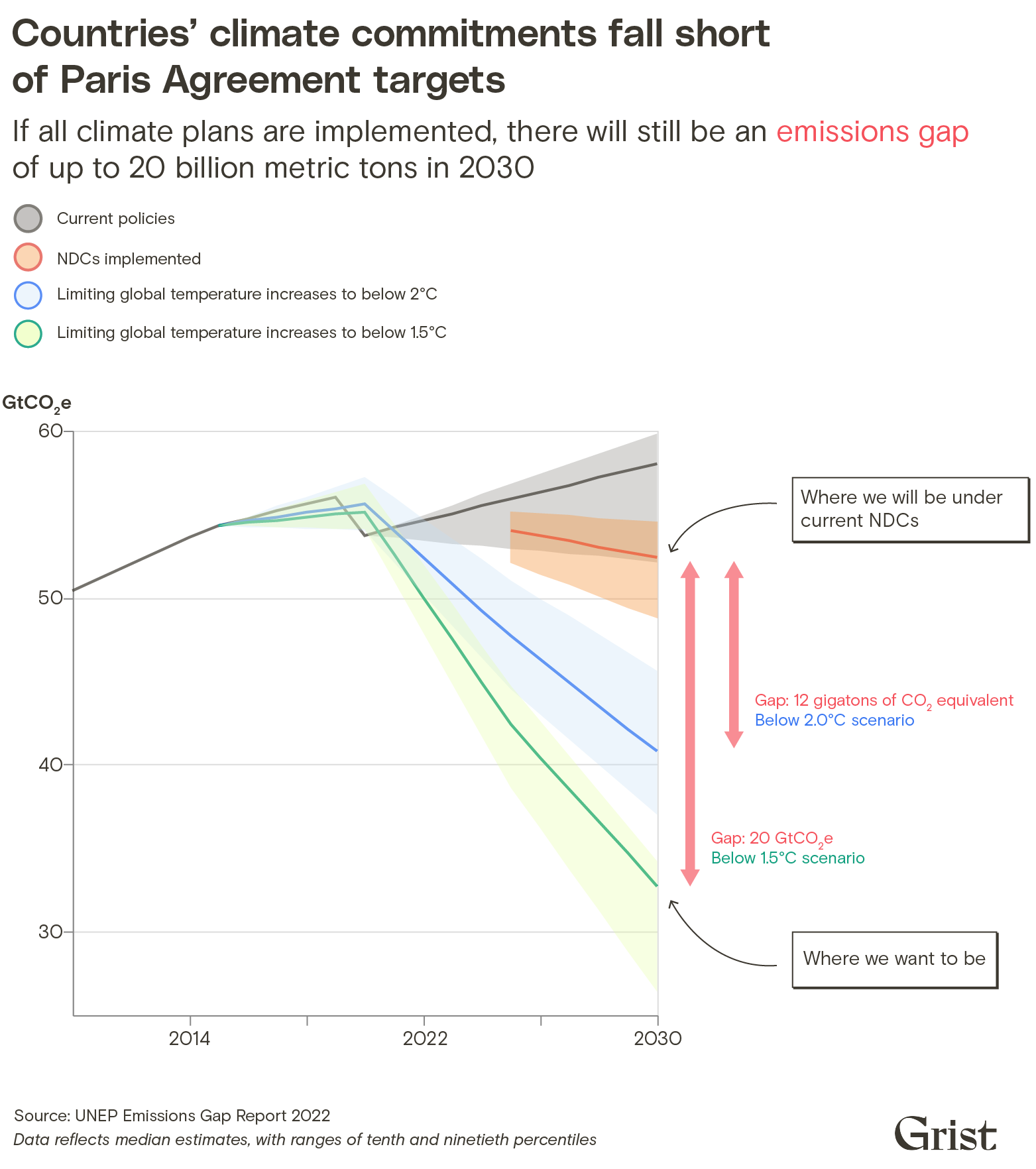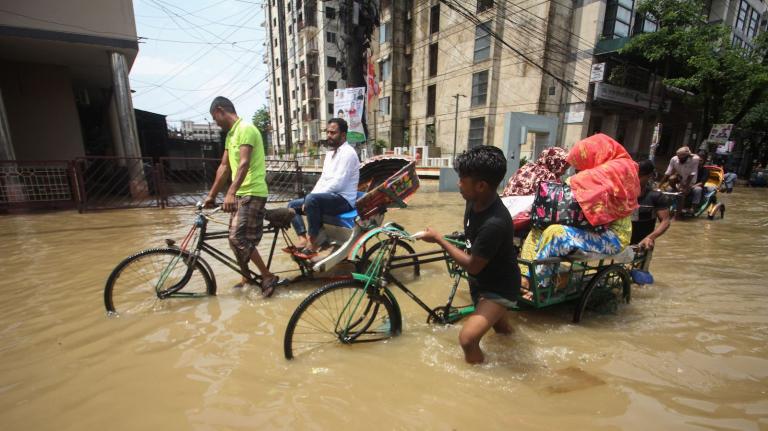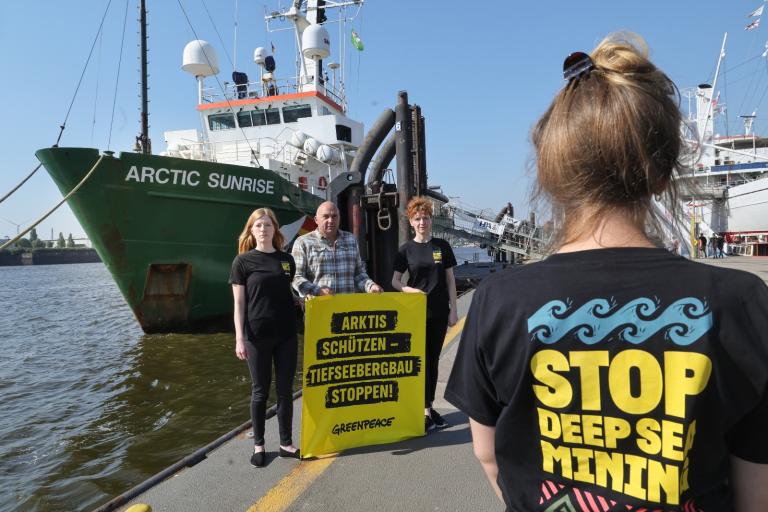Last November, world leaders gathered in Glasgow, Scotland, for COP26, the United Nations’ annual climate conference, to negotiate a new pact to keep global warming at bay. Although many countries had scaled up their commitments to cut emissions prior to the meeting, officials at the conference determined that these plans were still not ambitious enough to achieve the goals of the 2015 Paris Agreement. The final pact from COP26 called on United Nations members to “revisit and strengthen” their strategies.
But one year later, as officials gear up for another round of talks at COP27 in Sharm el-Sheikh, Egypt, next month, little has changed. On Thursday, the United Nations’ Environment Programme published its annual “Emissions Gap Report,” which found that nations’ current climate plans, if fully implemented, would not limit global warming to 1.5 degrees Celsius, or 2.7 degrees Fahrenheit, this century — the ambitious target set down in the Paris Agreement.
“There’s been a bit of a plateau in the progress that we were seeing in the lead-up to Glasgow,” said Taryn Fransen, a senior fellow at the nonprofit World Resources Institute and a lead author of the report. “Globally, the state of progress has really slowed down in an alarming way.”
In order to have a chance at 1.5 degrees C, global emissions must drop 45 percent by 2030. But countries’ current plans — which are called nationally determined contributions, or NDCs, in the parlance of international climate talks — will only cut emissions by 5 to 10 percent by that date, according to the report. It found that the updated NDCs submitted to the U.N. after COP26 shaved off less than 1 percent of projected emissions. If all plans were implemented, the world would still heat up by 2.4 to 2.6 degrees C (4.3 to 4.7 degrees F). Scientists estimate that at 2 degrees C (3.6 degrees F), more than a third of the global population could experience extreme heat waves at least once every five years, coral reefs could decline by 99 percent, and sea levels could rise nearly 3 feet.

The chasm between NDCs and the Paris Agreement’s goals is not the only “emissions gap” the report highlights. Many countries don’t even have policies in place to execute their commitments. Existing policies put the world on a path closer to 2.8 degrees C (5 degrees F) of warming.
“Every fraction of a degree matters,” said Inger Andersen, executive director of the U.N. Environment Programme, in a press release, “to vulnerable communities, to species and ecosystems, and to every one of us.”
Though many countries aren’t matching their words with actions, the United States is no longer one of the major culprits. With the passage of the Inflation Reduction Act in August, the U.S. now has a more credible path to achieving its NDC of cutting emissions by 50 to 52 percent by 2030. This one piece of legislation will cut global 2030 emissions by about 1 gigaton — a billion metric tons — according to the report. “A gigaton is big. A gigaton is around a fifth of total annual U.S. emissions,” said Fransen.
Before the Inflation Reduction Act, the U.S. was viewed with skepticism by the international community due to a history of abandoning international treaties like the Paris Agreement, which former President Donald Trump pulled the U.S. out of, and an earlier climate pact, the Kyoto Protocol, which the U.S. signed but never ratified. Fransen said the new law “says to the international community, ‘We’re serious about this, we’ve passed legislation,’ which we’ve never done before.”
The emissions gap report names three key actions the world must take to get on track: avoid building new fossil fuel infrastructure that will lock in emissions for decades to come, advance and implement zero-carbon technologies, and pursue behavioral changes like more sustainable diets and energy-saving habits.
While the report’s long-term forecast does not look much better than it did a year ago, it doesn’t tell the whole story. The report did not account for Russia’s invasion of Ukraine, which has scrambled the international energy landscape.
It’s unclear yet whether the result will be net good for the climate. In an attempt to cripple Russia’s economy, the European Union has reduced its imports of Russian oil and gas and announced intentions to turn off the tap altogether over the next several years. The transition to renewable energy, which can be produced locally, has become a matter of energy security. Europe has ramped up its climate ambitions with proposals to increase renewable energy and energy efficiency targets and install millions of electric heat pumps to replace gas heating systems in buildings.
At the same time, European countries are burning more coal and looking to import natural gas from Senegal, Algeria, and other African nations, financing fossil fuel development across the continent. The U.S. is also ramping up natural gas exports to Europe. The emissions gap report notes that early assessments estimate that investments in fossil fuel projects increased this year.
If that’s the case, it’s evidence of a key inhibitor to climate action, according to the authors. Investment in climate mitigation needs to increase by a factor of three to five. The financial system — banks, institutional investors, and the public institutions that regulate them — remains focused on short-term profit and is not accounting for long-term climate risks. In order to change that, the report says financial institutions need better information about climate risks. It also calls for policymakers to step in, both by making polluters pay for their emissions and by incentivizing financial actors to invest in a low-carbon economy.
“We had our chance to make incremental changes, but that time is over,” said Andersen.



